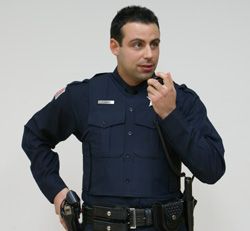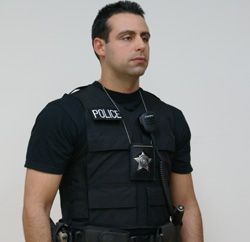Whether they admit it or not, some police don’t wear body armor.
What would make an otherwise fastidious officer compromise his safety on the streets? Turns out, basic lack of comfort is to blame.
 (Photo/J.G. Uniforms) |
Most officers have experienced ill-fitting body armor that’s too tight, too hot or too cold — but rarely just right. To remedy this, many departments have started issuing outer vest carriers, the most notable of which was pioneered by a
Functional benefits include the freedom to take body armor on and off, temperature control and a customized fit that is especially important for the safety of smaller or female officers.
“For body armor to work properly, it needs to fit properly,” said Street Survival Seminar instructor Sgt. Betsy Brantner Smith. “If you use an outside carrier, make sure it’s designed for your individual vest. An outside carrier tends to be more comfortable than armor worn under the shirt, but make sure that it lies close to the body and fits properly.”
Some of the major body armor manufacturers (including U.S. Armor, Lifetek, Armor Express, Safariland, Second Chance and American Body Armor), have started making their own versions of exterior carriers. Armor Express offers traditional looking exterior carriers, which provide many functional benefits, but do not look like a uniform. Their outer vests come in stock sizes. (For the extra-hard workers, Armor Express lines carriers with lined with anti-microbial and odor resistant fabric).
Second Chance Armor makes carriers to personal specifications through their online measurement guide. Their “Uniform” carrier is exactly that – “looks and feels like an officer’s uniform shirt.” You can even request your own color. Second Chance also boasts the “Dress Vest,” a carrier “designed for working undercover in plain clothes or for off-duty protection.”
“Customers are justifiably very peculiar about how they want these to fit,” said Greg Gala, General Manager of J.G. Uniforms. “For instance, they don’t want their carrier to sit over the duty belt because when they sit down it would hit their duty belt, rise and pinch their neck.”
 (Photo/J.G. Uniforms) |
That’s where customized tailoring comes in. The best fittings are still done the old-fashioned way — in person — but if that’s not in the cards, you can simply key in your measurements online.
While there is no significant difference in weight between regular body armor and outer vests, there is a significant difference in temperature control.
Traditional panels absorb outside air lie close to the skin. This can result in either bracing cold or insufferable heat. Exterior carriers, on the other hand, add a few layers, which means your body can breathe — and self-regulate.
Lead Street Survival Seminar instructor Lt. Jim Glennon is an outer vest convert.
“It’s a regular ballistic vest, but you wear this one on the outside,” he said. “It gives you more freedom. You can take it off while booking the put it on again before going back out.”
What’s more, he says, the carrier’s pockets mean that you can take items off your duty belt, which displaces a significant amount of weight. Many officers complain of being too weighted down by their duty belt; some complain of long-term injury from hefting gear around their hips.
Glennon said the following arrangement works best for him: “On the bottom right-hand side I have a mini-MagLite, a pouch next to that for my phone, and on the other side, in a holster on the bottom of the vest, is my Taser.”
More and more, you’ll find a larger array of options for extra pockets for flashlights or mace – whatever you need to carry. For officers on the street who need easy and immediate access to their tools, these options mean increased safety.
And how does it look?
In a word, sharp.
Major agencies in the Midwest have enthusiastically signed on to the professional look of these vests, including
The trend is quickly spreading to the coasts.
Gala said these exterior carriers are designed with the patrol officer in mind. “Our goal is to not make it not look too tactical looking, since they’re still patrol officers out there doing their regular job,” he said.
Sounds pretty good, you say. So what’s the catch?
Just one, Smith says: Ease of removal.
“Don’t be tempted to take it off in an uncontrolled environment, such as a restaurant, a coffee shop or during an extended call,” she said.
In other words, just because you can take it off, doesn’t mean you should.
For your armor to work, it has to be on.












